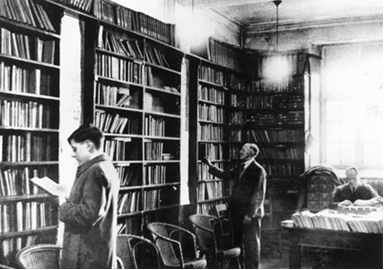Oakdale Workmen's Institute
24

Oakdale Workmen’s Institute
Imagine a time when there were no televisions, no social media and no mobile phones.
In the early part of the 20th century, many men were away fighting in the First World War (1914 -18), including the Battle of the Somme, and there was great hardship in Wales as well as the rest of Britain.
The radio, newspapers and word of mouth were the primary sources of information for people.
This was the background of the country when Oakdale Institute was built in 1916.
There were many ‘Stutes’, as they were known, in the South Wales valleys during the late 19th and early 20th centuries.
Where was Oakdale Institute originally built?
This institute was originally built in Oakdale, a mining village about 14 kilometres north of the town of Caerphilly.
Here is a photo of the institute in its original setting and where it is located now in St. Fagans National Museum of History.


Why was Oakdale Institute built?
Oakdale was built to provide leisure and entertainment facilities for the local workers and their families.
Choirs, bands, drama societies and pigeon fanciers were among the groups which met in the institute.
Political rallies, concerts, lectures and dances were also organized there too. In later years it also had a cinema and billiard hall.

Oakdale Institute today is comprised of the three main rooms downstairs: the reading room, the library and the committee room, and the main hall upstairs.
Its layout is still very similar to the original building as these photos of the library show.


Many miners educated themselves through reading, particularly during strikes.
During the General Strike, the number of books borrowed increased by 100%.
In 1940, the library bought the books How Green Was My Valley by Richard Llewellyn, The Citadel, a novel about medical treatment in a fictional South Wales village before the NHS by A J Cronin and Seven Pillars of Wisdom by the Welsh archaeologist and army officer, T E Lawrence (Lawrence of Arabia).
‘Plenty of people undoubtedly studied in Oakdale Institute’. Ralph Thomas, Blackwood, born 1920.
Who built Oakdale Institute?
The workers of Oakdale borrowed money from Tredegar Iron and Coal Company to build the institute.
Oakdale in its later years
The community faced hard times during the 1926 General Strike and the Depression in the 1930s.
There was a great deal of unemployment in the area and the institute supported families as much as possible. During the Second World War, evacuees, American troops and the Bevin Boys came to the area.
As a result more income was generated and the building debt was paid off by 1945.
After the end of the Second World War, society began to change, and people’s lives were altered by the arrival of television and cars, the latter meaning that travelling elsewhere for entertainment was a great deal easier.
In the early 1970s, the institute became a licensed club and finally closed in 1987. Shortly afterwards, Oakdale Colliery also closed.
When was Oakdale Institute opened at the Museum?
Oakdale Institute was officially opened at the Museum on 14 October 1995 by the Rt Hon. Neil Kinnock, former MP for the constituency of Bedwellty, the area in which it was originally situated.
Points of interest
Nowadays, Oakdale Institute is frequently used for civil wedding ceremonies.
Exhibitions are organised as well as conferences and activities during special events.

Famous people associated with Oakdale include Paul Hamlyn, founder of the publishing group Hamlyn, who once worked as a Bevin boy at Oakdale Colliery, Margaret Price, the opera singer, Joe Calzaghe, the boxer and members of the Manic Street Preachers.
Further reading: Building on strong foundations: Oakdale Workmen’s Institute

Building facts:
- Original Location: Oakdale, Gwent (Monmouthshire)
- Date originally built: 1916
- Dismantled & rebuilt at St Fagans: 1989
- Opened to the public: 1995
- Visiting information